The content of the article
Anthurium grown in the tropical forests of South America, it is difficult to adapt to the temperature conditions of the temperate climate zone. The flower has more than 900 varieties, but only 4 take root in ordinary city apartments. The plant, which is called the damn language and male happiness, is recommended to be grown in mini-greenhouses or arboretums, or to choose the right room, in which it is always warm and humid.
First meeting
Beginning gardeners are recommended to pay attention to Anthurium Scherzer. Unlike the Andre variety, it is stockier and less sensitive to low temperatures. Scherzer has a shortened stem, and the peduncle height reaches up to 30 cm.
If you need decorative and leafy varieties, you should buy Anthurium Crystal or Majestic. Such plants were covered with dark green, not bright red or orange, and the leaves were wide, covered with a net of white or silver veins.
It is recommended to purchase sprouts of anthurium in spring or summer, when it is warm enough, and it’s easier for the damn language to adapt to new conditions. Selected specimens must be left in the old pot for 2-3 weeks to get used to the plant. After the young sprouts are transplanted into another container, replacing the old soil with new.
What type of soil to choose
How well anthurium will be protected from fungus and parasites depends on the composition of the earth. What should be the ideal soil?
- slightly acidic;
- loose;
- moisture-intensive;
- contain a lot of nutrients;
- pass oxygen to the roots.
Flower shops offer universal compounds for anthurium, but they are too heavy for the gentle root system of male happiness. Some gardeners claim that the bloody tongue can be planted in the soil for orchids, but in such cases there are too few nutrients, which is why tropical plants weaken and wilt.
You can prepare the right soil at home. It is enough to mix turf with peat in a ratio of 1 to 2 and add 2 parts of moss. The second component provides food, and the third retains moisture, but does not allow fluid stagnation.
To create the perfect soil, you can use:
- composition for azaleas sold in flower shops;
- perlite;
- chopped pine bark;
- sphagnum.
It will take 2 parts of the first and second components and 1 of the third and fourth. Suitable for growing bloody tongue and hydroponics: a mixture of perlite with expanded clay or sphagnum without other additives. If such a base was used, the temperature in the room should not fall below +18. In winter and early spring, the anthurium is illuminated with phytolamps, and twice a month instead of water for irrigation, the root system is moistened with a solution for hydroponics.
Suitable for growing a tropical flower and soil consisting of:
- 4 parts of humus;
- 2 parts of coarse leaf turf that is not sieved;
- the same amount of peat;
- 1 parts of river sand.
To make the base loose and moisture permeable, charcoal, pieces of marsh moss and pine cones are added to it. You can mix the soil with coke fibers or crushed brick. Connect with wood chips.
The pot is first filled with a drainage layer, for which grated foam, clay shards, expanded clay or crushed stone are used. Hard material should be covered with moss or coconut fibers, and sprinkled with prepared soil on top.
Tip: The land when planting anthurium can not be too compacted, otherwise the flower will be difficult to gain a foothold in the soil.An overly dense base does not allow oxygen well enough for the damn language to grow.
Where to put anthurium
If cacti and hibiscus are happy to bathe in the sun, then red wax inflorescences can easily fade from the abundance of ultraviolet light. Anthurium, as a native of the tropics, loves heat and moisture, because in the wild he has to constantly get wet in the rain. But the flower has a complicated relationship with sunlight.
The plant needs ultraviolet light for photosynthesis and growth, and in South America there are practically no gloomy days. But in the natural environment, anthurium hides under tall trees with spreading crowns that scatter the sun's rays. Gentle and subdued light falls on the dark green leaves of the flower, which nourishes and warms. In direct contact with ultraviolet, the plant risks making burns and dying.
Pots with bloody tongue can be placed on the southern windowsills, but only if:
- there are blinds on the windows;
- a tree grows on the street, which casts a shadow on the anthurium;
- a film of brown or dark blue hue is glued to the glass;
- the flower is protected from ultraviolet radiation in other ways.
In other cases, for anthurium, they buy stands, shelves or hanging pots, which are placed 50-60 cm from the windows.
In winter, when the house becomes cool, the plant can be transferred to the kitchen or bathroom. In these rooms it is always hotter than in other rooms, and high humidity, almost like in tropical forests. In summer, a pot of wax buds can be taken out onto the balcony or left in the garden until evening, hiding under the largest tree.
Important: Do not place anthurium near batteries or other heaters. They dry the soil inside the pot and the plant becomes vulnerable due to pest attacks. You should protect the damn language from drafts and do not leave it near open windows.
Temperature and watering
From late spring to the beginning of winter in the room where the anthurium stands, it is recommended to maintain a temperature of + 20-25 degrees. Higher possible, the flower tolerates heat well. It is impossible below, otherwise growth stops and the lower leaves wither.
From the first days of December to mid-late January, you should reduce the temperature to +18, and after to +16. At the same time, you need to light up the plant with special lamps to compensate for the lack of heat.
Important: The lower the room temperature, the less moisture anthurium needs. If in the summer the flower is watered 3-4 times a week, then in the winter one, maximum two is enough.
Next to the damn language, it is recommended to install an ionizer or a humidifier. The leaves of the plant are regularly sprayed from the spray gun, trying not to get on the roots and stem. It is necessary to ensure that the earth in the pot does not dry out, but always remains slightly moist.
Anthurium is not often watered, but abundantly. If water accumulates at the bottom of the pot, you need to wait until the moisture evaporates. An excess of fluid leads to the appearance of a fungus, which primarily attacks the root system. It’s difficult to save the damn language, you have to change the soil and the pot, but even emergency measures do not guarantee that the plant will recover and will not fade.
What should be the water for irrigation? Warm, about 25-30 degrees. Irrigation fluid must be left to stand for 2-3 days, so that harmful impurities precipitate. You can use rainwater or thawed snow, but be sure to warm it up.
Fertilizer and water treatments
Anthurium needs to be fed twice a month. Both mineral and organic fertilizers are suitable. In March-April, when the growing season begins, and new leaves and inflorescences appear on the plant, it is recommended that nutrients intended for decorative-leafy varieties be added to the soil.
Pine chips or bark, some charcoal or moss can be added to the soil. Among the minerals, “Ideal” and “Kemira” are distinguished. If there is no desire to mess with liquid fertilizers, it is recommended to put granular ones into the ground during transplantation, which slowly dissolve and regularly feed the plant.
From May to the end of September, fertilizers should be used for decorative flowering species. This group includes:
- Uniflor-bud;
- Fertica Suite;
- Agricola.
Water the anthurium with a weak solution, reducing the dosage indicated in the instructions by half. Make water mixed with fertilizers under the root. After top dressing, water the flower with a clean liquid to improve the absorption of beneficial components. Fertilizers can burn the plant, so if the solution gets on the leaves or stems, they should immediately be wiped with a damp cloth.
Hygiene Against Pests
Anthurium needs not only to be fertilized and protected from ultraviolet radiation, but also regularly bathed. Water improves the appearance of leaves and inflorescences, washes the cobweb and small insects, which are difficult to notice with the naked eye. How to prepare the plant for hygiene procedures?
- Cover the bottom of the pot with a plastic bag or cling film. Make a small incision, wrap around the stem and tape over all joints and small holes with tape. The land after bathing should remain dry.
- Adjust the temperature of the shower: not too cold, but not too hot, closer to room temperature.
- Do not turn on too powerful a pressure so as not to injure the leaves.
- Hold the pot in one hand and the mixer in the other. If you put a flower in the bath, the drainage layer will absorb water, the soil will become too wet, and a fungus will appear, or the root system will begin to rot.
You need to wash the leaves of the anthurium on both sides, because the dust accumulates on the outside, and the cobweb and insect eggs on the inside. You can use a soft sponge or rag to better wash the flower from dirt.
After bathing, slightly blot the plant with a dry terry towel and put in a warm place until the moisture evaporates. Protect Anthurium from drafts and the sun. When the plant is completely dry, carefully remove the protective film from the pot and return to its original place.
Arrange water procedures should be 1-2 times a month. Each week, wipe the leaves and wax flowers with a damp cloth, trying not to leave marks and stains.
How and when to transplant a plant
The root system of the anthurium is constantly growing, so the young bloody tongue is annually transplanted into a more spacious pot. Nothing complicated:
- Tap the clay walls with a spatula to separate the ground with roots.
- Take out the plant with an earthen lump, gently pulling it up.
- Shake off the anthurium and clean the root system of the soil. Work carefully so as not to damage the delicate base of the flower.
- Pour a drainage layer and a little earth into a new pot.
- Place the plant in the center, add soil to hide the root system.
- Shake the pot several times and knock on the walls. The roots of Anthurium are strongly intertwined, and this is necessary so that the soil fills the voids between them.
- Add earth, water the flower and fertilize.
Transplant anthurium is recommended in the spring, when new leaves begin to form. The plant is easier to tolerate the change of the pot and adapts faster. Adult flowers are transplanted every 2-3 years, because they grow more slowly.
Tip: You do not need to buy a pot "for growth." In oversized containers, the root system becomes too thick. Anthurium has many leaves, but the plant does not bloom.
Pests
- Recognizing aphids that have decided to feast on young shoots is easy, and a solution of laundry soap or special preparations will help get rid of it.
- If dark spots appeared on the outside and tubercles on the inside, the scale was attacked by the anthurium.Insects do not tolerate laundry soap, and especially persistent individuals will destroy insecticides.
- Are old leaves covered with yellow spots and curled? Young are deformed? Anthurium eats a spider mite from which acaricide will relieve.
- On the roots appeared tubercles and strange densities? Symptoms indicate brown nematodes, which are not treated. Only isolation and destruction of the flower, so that the pest does not spread to other plants.
Growing anthurium is a complex and time-consuming process. The tropical guest is sensitive to temperature extremes, ultraviolet and cold, is sick from drafts and excess moisture. But if you regularly take care of the damn language and protect the plant from frost and sun, it will delight you with bright and unusual colors all year round.
Video: Anthurium Care

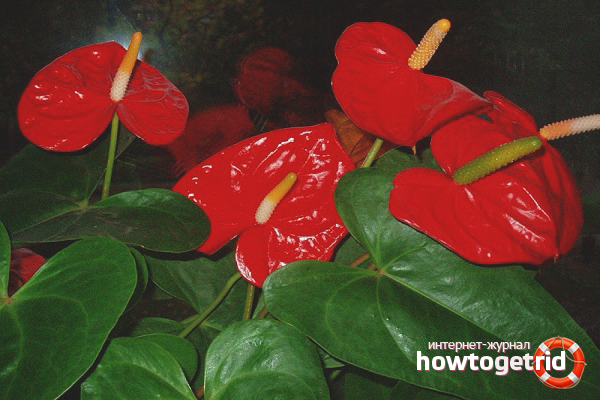
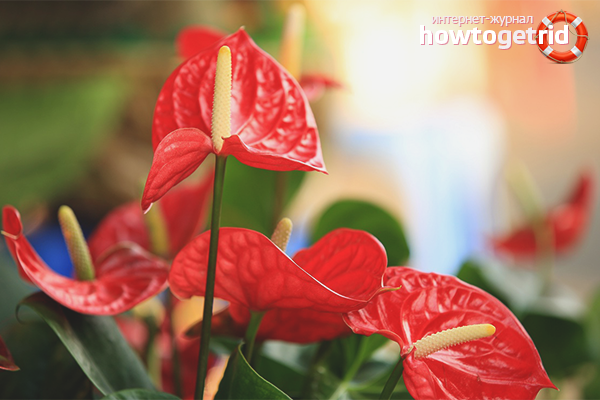
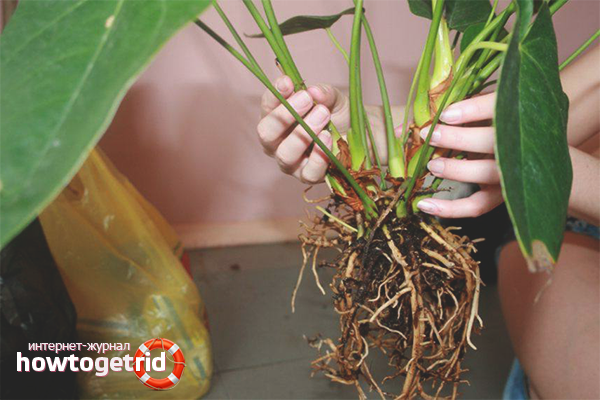


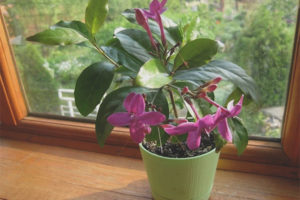



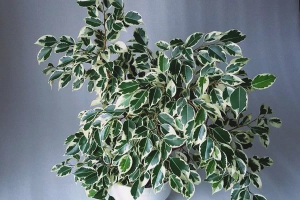

Submit